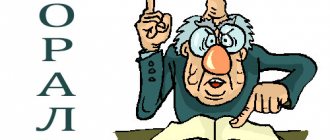Definition of moral principles
| Moral principles are a set of moral rules that apply to an individual, a group of individuals, or society as a whole. Most often acquired from childhood. |
In other words, moral principles are requirements that must be strictly followed in all life situations.
The formation of moral principles is strongly influenced by upbringing, family relationships, religion, environment, and culture. What seemed unacceptable and reprehensible some time ago may become the norm and not cause condemnation. And vice versa: some things that were considered ordinary may become completely unacceptable.
It is moral principles that allow a person to choose the right path in life and influence decision-making in accordance with his conscience throughout his life, giving him a general direction for his activities.
Every person goes through several stages of moral development at different stages of his life, and his own moral principles can change under the influence of external factors.
Moral principles are something that is formed and can change throughout life, is relevant for a particular society and for each person separately, without these principles the existence of a harmonious society is impossible.
How is morality formed?
Worldviews improve as any social system matures. The formation of morality depends not only on the maturity of social foundations, but also on nationality and race, on the geographical location of the region where society lives. What morality is in social science can be understood by tracing the pattern of development of society. In the primitive communal and subsequent early formations of people, the principle of Talion (a tooth for a tooth) prevailed. In modern Western-style societies, the main moral law is tolerance.
History of the term "morality"
It is impossible to say exactly when society first began to think about what morality is.
The earliest source that describes this concept is the parables of Solomon (mid-10th century BC). During Homer's life, society was well aware of conscience, virtue, honor, and legality.
Confucius (6th–5th centuries BC) wrote about issues of morality and morality, who considered mercy, philanthropy and integrity to be the most important universal values.
Cicero made a great contribution to the formation of the concept of morality. He talked a lot about how ethics, morality and law relate to each other. He sought to show that it is impossible to separate the concepts of law and morality, since together they make it possible to rid society of chaos and create order. Of course, Cicero, who lived in the 1st century BC, was far from a pioneer on this topic. But it was he who introduced the definition of morality that we still rely on today.
Pythagoras, Socrates and Plato also raised questions of morality in their contemporary society and gave examples of highly moral behavior by the standards of that time.
The term “morality” originates from the Latin moralitas, moralis, mores - tradition, folk custom, behavior, and later - disposition, character, mores. Ancient Roman authors translated the word as “conformity to good morals.” In the 18th century, a similar word was used in French and meant “equal to the law, legitimate.” The word “morality” also came into Russian through French (la morale) in the 18th century.
Prepare for the Unified State Exam in Social Studies with courses from Skysmart - fun and effective!
Social studies abstract on the topic “Religion, morality, social mobility”
The essence of morality
Morality arose in primitive society. Morality regulates the behavior of people in all spheres of public life: in work, in everyday life, in politics, in science, in family, personal, inter-class and international relations. In contrast to the special requirements placed on a person in each of these areas, the principles of morality have a socially universal significance: they apply to all people, capturing in themselves that common and fundamental thing that makes up the culture of interpersonal relationships and is deposited in the centuries-old experience of the development of society.
The concept of “morality” comes from the Latin word moralis
, which translated means “moral.”
A synonym for morality is the concept of morality
.
Morality
is a set of principles and norms of behavior of people in relation to each other and to society as a whole.
Morality is studied by a special science - ethics
.
Moral standards
- these are the beliefs and habits of people, the ideals of good, evil, justice, etc., based on public assessments. Moral norms regulate a person’s internal behavior and dictate an unconditional requirement to act in a specific situation “one way and not another.” Moral norms reflect the needs of man and society not within the boundaries of certain, particular circumstances and situations, but on the basis of the vast historical experience of many generations. Therefore, through moral standards, both the goals pursued by people and the means of achieving them can be assessed.
Secular and religious morality are distinguished.
Secular morality
- reflects the needs of man and society based on the historical experience of many generations, it is a reflection of the traditions and mores of society as a whole.
Religious morality
- a set of moral concepts and principles that develop under the direct influence of a religious worldview. Religious morality asserts that morality has a supernatural, divine origin, and thereby proclaims the eternity and immutability of religious moral institutions, their timeless, supra-class character.
Morality performs a number of important functions
.
- Regulatory function
- regulates the behavior of people in society, controls the lower limit of human relations, beyond which comes responsibility to society. Moral regulation differs from legal regulation in that the influence of the former is determined by principles operating from within the person himself, while law is an external superstructure.
- Educational function
— prepares a person for life in society, acts as one of the types of socialization of the younger generation. Moral education continues throughout life from the moment of formation of a person’s consciousness through self-education in the period of maturity. If in childhood a child receives primary moral ideas, then later he independently develops them, turning them into his own moral world.
- Communication function
— creates a normative basis for human communication (etiquette, rules of communication, rules of decency).
- Cognitive function
- allows you to recognize and evaluate human qualities.
In this regard, we note that moral knowledge is knowledge about what is proper, what is fair, about what is absolutely prohibited, about good and evil.
Thus, morality is also a characteristic of a person, his main qualities. At the same time, this is a characteristic of relationships between people, the entire set of moral norms that guide people in their lives.
Religion as a cultural phenomenon
Religion is one of the oldest and main (along with science and education) forms of spiritual culture and the most important factor in human history.
The word "religion" comes from the Latin religio
- piety, piety, shrine, object of worship.
Religion
is a worldview and attitude that is based on the belief in the existence of one or more gods, i.e. such a beginning that is beyond natural knowledge and inaccessible to human understanding.
In the structure of religion
The following elements
can be distinguished .
- Faith
into the existence of God as the creator of all things.
Foundations of Faith
: Holy Scripture, eyewitness accounts, miracles.
The opposite of faith is atheism
- lack of faith in God.
- Teaching
- this is a set of principles of ideas and concepts - enshrined in the Holy Book (Bible, Koran).
- Religious activity (cult)
- this is the entire set of actions that believers perform for the purpose of worshiping God.
- Religious institutions
called a community or church.
Religion plays a huge role in public life. The functions of religion are understood as the various ways in which it operates in society. As the most essential functions of religion
The following are highlighted.
- Worldview function - explains to a person the phenomena of the surrounding world and its structure, indicates what the meaning of human life is.
- Compensatory function
- gives people comfort, hope, support, reduces anxiety in various risk situations. It is no coincidence that people most often turn to religion during difficult moments in their lives.
- Educational function
— educates and ensures the connection of generations.
- Communication function
— carries out communication between people, primarily in religious activities.
- Regulatory function
— religious morality regulates the behavior of people in society.
- Integrative function
- promotes the unification of people, uniting their thoughts, feelings and aspirations.
There are different forms of religious beliefs
.
- Cult of nature
— the cults of Heaven and Earth are usually distinguished. The sky is inhabited by gods who control the lives of people, and the gods of the Earth control natural processes.
- Animism
- all things, objects and natural phenomena are endowed with a spiritual principle. These spirits participate in a person’s affairs, help or hinder him.
- Totemism
- a form of belief in which a person is considered as a descendant of some animal (totem).
- Ancestor cult
- this is a belief in a mystical connection with dead generations, worship of the spirits of dead people.
- Polytheism
- belief in many gods, among which the main god usually stands out. The rest of the gods are his children and relatives and obey him.
- Monotheism
- This is monotheism, the belief in the existence of one God. He is interpreted as the Creator, the real beginning of the world, the Lord and King of Heaven.
International, world, universal, monotheistic religions that have become widespread among different nations are Buddhism, Christianity and Islam. The emergence of world religions is the result of a long development of political, economic and cultural contacts between different countries and peoples. Ethnic and national partitions characteristic of ancient religions were replaced by religious partitions. The cosmopolitan nature of Buddhism, Christianity and Islam allowed them to transcend national boundaries, spread widely across the globe and become world religions.
World religions are characterized by belief in a single, omnipotent, omnipresent, omniscient God. The one God of monotheism, as it were, combines in one image all those qualities and properties that were inherent in the numerous gods of polytheism. Each of the three world religions developed in a specific historical environment, in the conditions of a certain cultural and historical community of peoples. This circumstance explains many of their characteristic features.
Let's consider the main features of world religions
.
- Buddhism
- the oldest world religion.
Originated in the 6th-5th centuries. BC. in India. two schools of thought
in Buddhism :
1) Hinayana;
2) Mahayana.
The essence of the teachings of Buddhism
: through reflection and contemplation a person can achieve the truth, find the right path to salvation, to God. If he leads a virtuous and merciful life, then death will be a transition to a higher state - nirvana. One of the most important precepts of Buddhism is love and mercy for all living beings.
- Christianity
- arose in the 1st century.
AD on the territory of the Roman Empire. Currently, it is the most widespread religion on Earth. There are three branches of Christianity
:
1) Catholicism;
2) Orthodoxy;
3) Protestantism.
The Central Idea of Christianity
- this is the idea of man's sinfulness as the cause of all his misfortunes. A person can get rid of sins through prayer and repentance.
- Islam (Muslim)
- the youngest world religion.
Originated in the 7th century. AD on the Arabian Peninsula, in the territory of Arab tribes. “Islam” translated into Russian means “submission”. There are two directions
in Islam :
1) Sunnism;
2) Shiism.
Basic ideas of Islam
- man is inherently sinful, he can only rely on the mercy and will of Allah. If a person believes in God and follows the instructions of the Muslim religion, he will deserve eternal life in paradise. A characteristic feature of the Muslim religion is that it intervenes in all spheres of people's lives. Personal, family, social life of believers, politics, legal relations, court - everything must obey religious laws.
Islam and Christianity are characterized by fatalism
- the belief that the fate of a person and all his actions and deeds are predetermined by God and are written in the “Book of Fates.”
The Constitution of the Russian Federation, in Article 28, legislatively enshrines freedom of conscience and religion - a person has the right to choose his own religion or to be an atheist.
Freedom of conscience is the freedom to profess or not to profess any religion.
Tasks
- for a grade of “5”: answer 4 control questions orally for a grade of “5”
- for a grade of “4”: answer 3 control questions orally for a grade of “5”
- for a grade of “3”: write down the answers to 4 questions in your notebook.
1. Define the concept of “religion”.
2.What is morality understood in social science?
3.Characterize world religions.
4.What does the term “Freedom of conscience” mean?
Social mobility
People are in constant motion, and society is in development. The totality of social movements of people in society, i.e. changes in status, is called social mobility. This topic has interested humanity for a long time. The unexpected rise of a person or his sudden fall is a favorite plot of folk tales: A resourceful beggar suddenly becomes a rich man, a poor prince becomes a king, and the hardworking Cinderella marries a prince, thereby increasing her status and prestige.
However, human history consists not so much of individual destinies as of the movements of large social groups. The landed aristocracy is being replaced by the financial bourgeoisie, low-skilled professions are being forced out of modern production by representatives of the so-called “white collar” workers - engineers, programmers, operators. Wars and revolutions reshaped the social structure of society, raising some to the top of the pyramid and lowering others. Similar changes took place in Russian society after the October Revolution of 1917. They are still happening today, when the business elite is replacing the party elite.
There are two main types of social mobility - vertical and horizontal.
Vertical mobility
implies movement from one stratum (estate, class) to another.
Depending on the direction of movement, there is upward mobility
(social ascent, upward movement) and
downward mobility
(social descent, downward movement). Promotion is an example of upward mobility, dismissal, demotion is an example of downward mobility.
Horizontal mobility
implies the transition of an individual from one social group to another located at the same level. Examples include moving from an Orthodox to a Catholic religious group, from one citizenship to another, from one family (parental) to another (one’s own, newly formed), from one profession to another. Such movements occur without a noticeable change in social position in the vertical direction.
A type of horizontal mobility is geographic mobility. It involves moving from one place to another while maintaining the same status. An example is international and interregional tourism, moving from city to village and back. If a change of location is added to a change of status, then geographic mobility turns into migration
. If a villager came to the city to visit relatives, then this is geographical mobility. If he moved to the city for permanent residence and found work here, then this is already migration.
Social mobility can be group
when an individual goes down or up the social ladder together with his group (estate, class), and individual when he does this independently of others. The reasons for group mobility are factors such as social revolutions, foreign interventions, invasions, interstate wars, civil wars, military coups, changes in political regimes, replacement of the old constitution with a new one, etc.
To the factors of individual mobility
, i.e. The reasons that allow one person to achieve greater success than another, scientists include the social status of the family, level of education, nationality, physical and mental abilities, external characteristics, education, place of residence, advantageous marriage.
The paths and mechanisms through which people rise to the top are called channels of vertical mobility
.
Since vertical mobility exists in any society, even in a primitive one, between strata there are various “openings”, “elevators”
along which individuals move up and down. The most famous channels are politics, army, church, school, family, property.
Army
functions as a conduit for vertical mobility in wartime. Large losses among the command staff lead to filling vacancies from lower ranks. Soldiers move up the social ladder through talent and courage. Having risen in rank, they use the resulting power as a channel for further advancement and accumulation of wealth. It is known that out of 92 Roman emperors, 36 achieved power starting from the lowest ranks. Of the 65 Byzantine emperors, 12 were promoted through military careers. Napoleon and his entourage, marshals, generals and the kings of Europe appointed by him came from commoners. Cromwell, Grant, Washington and thousands of other commanders rose to the highest positions through the army.
Church
as a channel of social mobility moved a large number of people from the bottom to the top of society. Gibbon, Archbishop of Reims, was a former slave. Pope Gregory VII is the son of a carpenter. Sociologist P. Sorokin studied the biographies of 144 Roman Catholic popes and found that 28 came from the lower strata, and 27 from the middle strata. The institution of celibacy (celibacy), introduced in the 11th century. Pope Gregory VII, obliged the Catholic clergy not to have children. Thanks to this, after the death of church ministers, the vacant positions were filled with new people. In addition to upward movement, the church was a channel for downward movement. Thousands of heretics, pagans, enemies of the church were put on trial, ruined and destroyed. Among them were many kings, dukes, princes, lords, aristocrats and nobles of high rank.
Institutes of Education
and education, no matter what specific form they took, have served in all centuries as a powerful channel of social circulation. Democratic countries are societies where schools are accessible to all members. High competition for admission to colleges and universities in many countries is explained by the fact that education is the fastest and most accessible channel of upward mobility. In such a society, the “social elevator” moves from the very bottom, passes through all floors and reaches the very top. An example is ancient China. During the era of Confucius, schools were open to all grades. Exams were held every three years. The best students, regardless of their family status, were selected and transferred to high schools and then to universities, from where they were promoted to high government positions.
Own
manifests itself most clearly in the form of accumulated wealth and money. They are one of the simplest and most effective ways of social promotion. In the XV-XVIII centuries. European society began to be ruled by money. Only those who had money, not noble birth, achieved high positions. The last periods of the history of Ancient Greece and Rome were the same. P. Sorokin established that not all, but only some occupations and professions contribute to the accumulation of wealth. According to his calculations, in 29% of cases this allows the occupation of a manufacturer, in 21% - a banker and stockbroker, in 12% - a merchant. The professions of artists, painters, inventors, statesmen, miners and some others do not provide such opportunities.
Family
and
marriage
become channels of vertical mobility if representatives of different social statuses enter into a union. In European society, the marriage of a poor but titled partner with a rich but humble one was common. As a result, both moved up the social ladder, getting what each wanted. We find an example of downward mobility in antiquity. According to Roman law, a free woman who married a slave became a slave herself and lost her status as a free citizen. The family has become the main mechanism of social selection, determination and inheritance of social status. Coming from a noble family does not automatically guarantee good heredity and a decent education. Parents cared about the best upbringing of their children; this became a mandatory norm for the aristocracy. In poor families, parents could not provide adequate education and upbringing. They could be given by noble families. The managerial elite was recruited from them. The family has become one of the institutions for distributing members of society into strata.
Control questions
- What elements are included in the concept of “social structure of society”?
- Explain the concept of “social group”.
- What types of social groups do you know?
- What types of ethnic groups do you know?
- What is nationalism?
- How do you understand the concepts of “national identity”, “national mentality”, “national character”?
- What is social differentiation?
- How do you understand the concept of “social stratification”?
- What types of social stratification do you know?
- What are the features of social stratification in modern Russia?
- What is social mobility?
- What types of social mobility do you know?
Approaches to understanding morality
There are four approaches to understanding morality:
- Religious. Its adherents believed that the source of morality is the absolute. To curb his passions, a person is forced to turn to God for help. Faith in him helps to follow the absolute rules of behavior.
- Evolutionary. In the process of natural selection, a person acquires and inherits a certain line of behavior. According to this version, morality comes from the instinct of sociability of people.
- Naturalistic. The root cause of morality is nature. The human mind defines natural moral values as good or evil.
- Cultural. Morality is one of the elements of society's culture.
Morality in the 21st century
Human resource management - what it is, principles and functions of the process
Currently, moral principles are increasingly being declared archaic or classified as prejudices. It is believed that modern moral norms must be scientifically substantiated, sufficiently reasoned, and subject to logic. Current society does not accept many rules of morality only on faith without an evidence base. However, personal moral standards are formed for each person based on his worldview and personal beliefs.
Important! The biblical 10 commandments are relevant and universal to this day and are not denied by modern adherents of logical morality.
The eternal struggle between good and evil
Basic functions of morality
Morality performs the following functions:
- The integrative function of morality is to harmonize the internal state of a person.
- The evaluative function of morality is associated with a person’s ability to determine the criteria for his own and others’ actions based on the concepts of good and evil. Moral assessment is expressed in praise, blame, agreement, etc.
- The regulatory function of morality determines activities taking into account the needs of surrounding people and the entire society. Morality establishes social norms to be observed, imposes sanctions, and maintains rules of behavior.
- The controlling function of morality is checking the compliance of a person’s behavior with the norms established in society. Self-control based on the judgment of others or conscience.
- The educational function of morality is a mechanism for learning to live in society: how to learn to reckon with other people. Morality teaches us to understand and accept their needs and interests, shapes the individual’s personality, his worldview and personal concepts of good and evil.
- The value-orienting function of morality forms life values and moral goals for each person, lays down the concept of the meaning of life.
Concept
In society there are rules of behavior that are not written down in documents, but are observed by the majority of people. For example, in the professional sphere. A person shows love for his work, tries to be useful, accumulates knowledge and skills that contribute to his more successful activities. All this is not established by special acts and operates without any written form. Family and friendly relationships are also built, in which, for example, it is customary to respect and love each other, not lie, and support in difficult situations.
In this regard, the question arises: is there some kind of system of unspoken rules that is the same for the entire society? Morality acts as such a system.
Morality is a set of norms accepted in society that regulate relations between people, their mutual responsibilities and rights from the standpoint of good and evil.
Classification of moral principles
A person recognizes moral principles as behavior that determines the nature of relationships in society.
The following moral principles are distinguished:
- The principle of humanism is the highest human value, which is expressed in love for one’s neighbor, protection of dignity, recognition of the right to a happy existence and self-realization.
- The principle of altruism is a moral norm that calls for providing selfless support to those in need.
- The principle of collectivism is the possibility of coexistence to achieve a common goal. It consists of cooperation, mutual assistance, and democracy.
- The principle of justice is equal rights and freedoms for all members of society. Social and economic benefits are available to everyone without exception and are distributed depending on the amount of effort on the part of each person.
- The principle of mercy is the willingness to sympathize and help those who ask, regardless of social status and appearance.
- The principle of peacefulness is based on the recognition of human life as the highest value. It assumes respect for national and regional characteristics and state sovereignty. Peacefulness helps maintain social order and mutual understanding between generations.
- The principle of patriotism is love for the Motherland, care for it, readiness to defend it from enemies, pride in state achievements, respect for history and respect for national property.
- The principle of tolerance means respect, acceptance and correct understanding of the rich diversity of cultures of our world, forms of self-expression and ways of manifesting human individuality. In other words, accepting the diversity of cultures without the desire to suppress or correct them.
Test on the topic
- /10
Question 1 of 10The set of unwritten rules of behavior and norms accepted in society is:
Start test
Hall of Fame
To get here, take the test.
- Danil Meshcheryakov
9/10
- School-Library Mbou-Bogradskaya-Sosh
10/10
- Alina Gromova
10/10
- Dima Semikin
9/10
- Svetlana Abakshina
7/10
Moral principles of communication
Moral norms and principles in the context of communication:
- self-respect and showing respect to interlocutors;
- priority of other people's or public interests over personal ones;
- conscious avoidance of using life's benefits for the sake of achieving a set goal;
- tackling complex social problems and working under extreme conditions for higher goals or ideals;
- responsibility and free care for those in need;
- building relationships with members of society based on kindness and benevolence;
- recognition of the inviolability of the personal dignity of each person;
- politeness and respect for the interlocutor, the use of generally accepted ethical standards;
- communication is a two-way process, not a monologue, each participant contributes to it;
- equality of parties participating in communication, regardless of gender, age, social status;
- sincerity in expressing feelings, truthfulness of transmitted information;
- clarity and accessibility for all participants in communication;
- consistency and correct order of communication elements, for example, question-answer, encouragement to respond.
Morality and morality - similarities and differences
Similar concepts have common characteristics:
- are based on the same basic concepts;
- have common rules and ideas;
- accepted by the whole society;
- are not mandatory.
The difference between morality and ethics:
- One applies to the social sphere. The other is to the spiritual.
- Morality can change its principles. Morality remains unchanged.
- Morality is relative (in different circumstances, the same act may be immoral). Morality is absolute in all cases.
- Violation of moral standards may result in sanctions from society. Only conscience punishes violations of morality.
Lack of moral principles
A complete absence of moral principles is impossible - a person in any case has some idea of what can and cannot be done. These ideas may differ significantly from those generally accepted in a particular society, then such a person may be called immoral. If a person stops developing his personality, stops setting goals and guidelines for himself, then he begins to degrade. Along with this, a regression of formed moral norms and rules begins.
What is immoral behavior?
This is a violation of moral principles, expressed in actions. Immoral behavior is directly related to weak spiritual and moral attitudes of the individual. Another reason is commitment to human vices. If an individual behaves immorally, it means that his parents and society did not instill in him certain standards of behavior that are considered moral in society. Further circumstances of life (the environment or being at the bottom of the social ladder) developed in him his own internal moral consciousness. It began to contradict morality in society.











